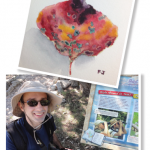Excluding the years he spent in medical school, Jonathan Paramo, MD, has always kept birds as pets. As an animal lover, he believes he shares a special chemistry with birds, specifically any species of parrots. When he’s around them, he says he experiences “a special feeling.”
“There are cat lovers and dog lovers, but you don’t find many bird lovers,” he says. “But we’re out there and a little bit unique and strange. I feel we’re a special kind of people because birds understand us and we understand them.”
Childhood Pets
When Dr. Paramo was 13 years old, he had formed a strong bond with his cousin’s pet—a vibrant, orange and yellow lovebird named Chuchupa. When his cousin could no longer care for the bird, Dr. Paramo brought the bird, a member of the parrot family, home with him.
At the time, young Jonathan lived in Miami with his family. They had recently adopted a stray dog. The dog constantly tried to snatch the bird out of the air when she flew around the house, succeeding in its hunt one evening when the family was in another room.
“I was definitely broken-hearted,” recalls Dr. Paramo, now a rheumatology fellow at Zucker School of Medicine at Hofstra/Northwell, Hempstead, N.Y. “I had the bird for several years. At 13, I never really thought Chuchupa was in danger [from the dog].”
A friendly cockatiel was the next addition to the family. While some birds attach to one person, Dr. Paramo says this bird was very outgoing and attached to multiple people. However, his father believed birds should be free, not kept in cages or people’s homes, and released the cockatiel into the wild.
“I had this bird for two years before my dad released it,” he says, adding that cockatiels survive in flocks and typically live for 20 years. “I was very upset about it, but hopeful that maybe I would find him nearby in a tree or that someone would come to me and say, ‘I found your bird.’ But I never saw him again.”
‘[Bird lovers are] a special kind of people because birds understand us & we understand them.’
Despite these traumatic childhood experiences, Dr. Paramo was determined to have birds as pets. While still a teenager, he purchased two, yellow and orange parakeets. Now a more experienced pet owner, he loved and cared for these birds like some teenage boys care for their cherished cars. However, both birds eventually died of an undiagnosed illness.

